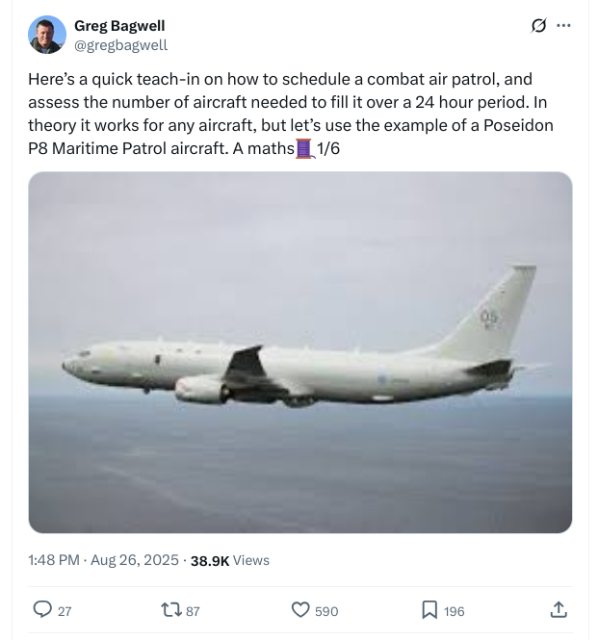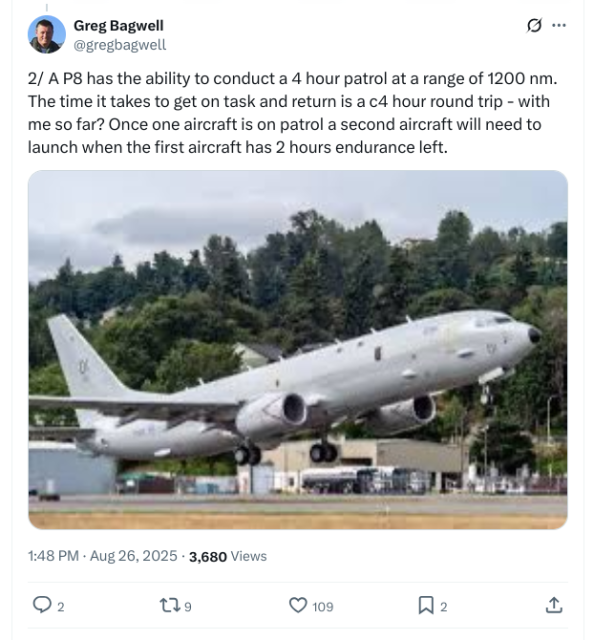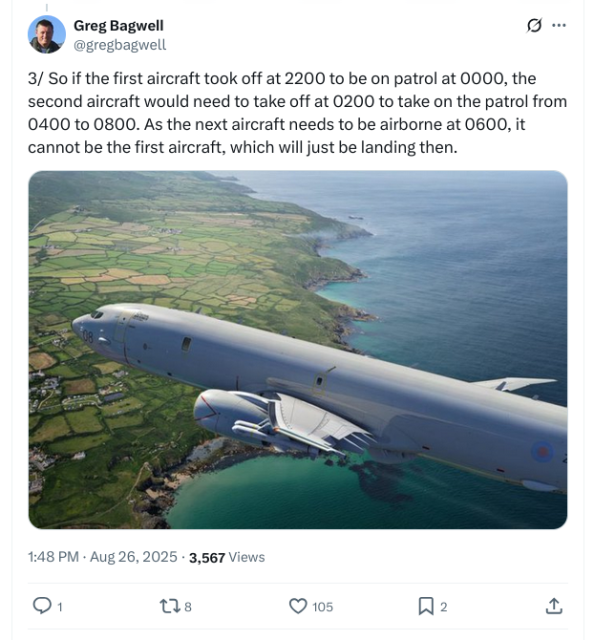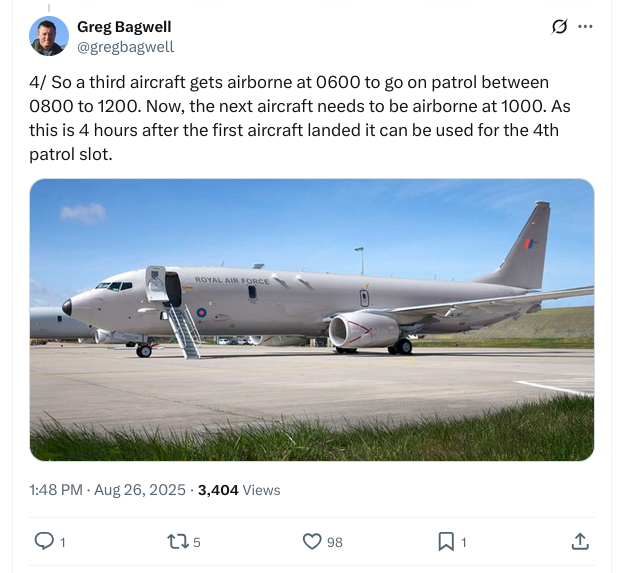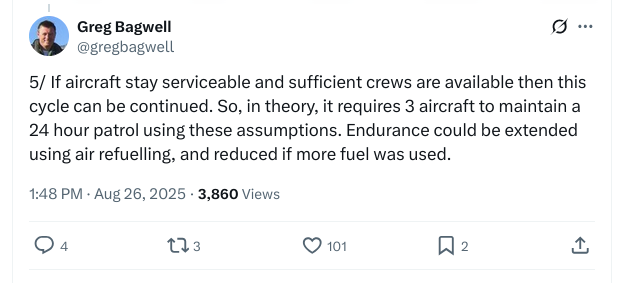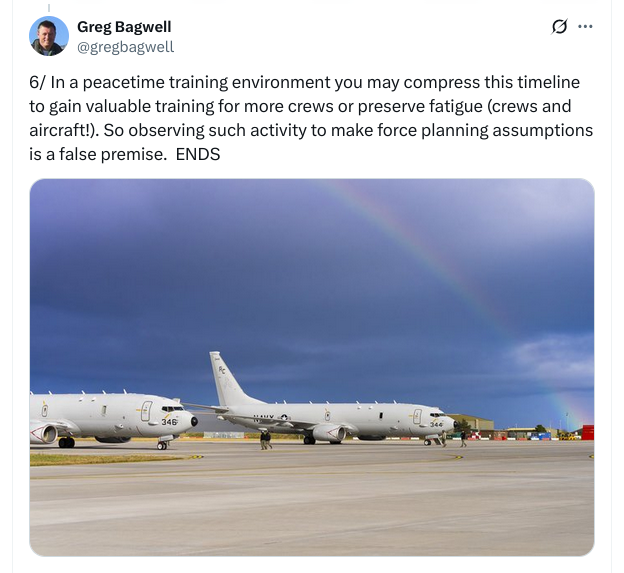I was fascinated by Greg Bagwell’s thread on X/Twitter last week and I can’t help wanting to share it with you.
Greg Bagwell CB CBE is a retired senior Royal Air Force commander who served 36 years, ending his career as Deputy Commander (Operations) at RAF Air Command – the service’s most senior operational role. He commanded major operations and has over 4,000 flying hours, primarily on Tornado aircraft.
His thread breaks down something that sounds deceptively simple but gets complex fast: the mathematics of maintaining 24-hour air patrol coverage.
Here’s a quick teach-in on how to schedule a combat air patrol, and assess the number of aircraft needed to fill it over a 24 hour period. In theory it works for any aircraft, but let’s use the example of a Poseidon P8 Maritime Patrol aircraft.
His example is the Boeing P8 Poseidon, a modern maritime patrol and reconnaissance aircraft developed for the US Navy and allied forces, currently in operation in the US, UK, Australia, New Zealand, Norway, South Korea, Germany and Canada. The airframe is a strengthened Boeing 737-800 with a weapons bay, sonobuoy deployment system for anti-submarine warfare and dedicated military avionics. The P8 typically operates with a crew of nine: two flight crew and seven mission specialists. It has a maximum speed of 490 knots (564 mph or 955 km/h) with a ceiling of 41,000 feet (12,500 m). It has a combat radius of 1,200 nautical miles (1,383 miles or 2,225 km) with four continuous hours conducting its mission at the designated target area before needing to return the up-to-1,200-nautical-mile distance to get home again.
A P8 has the ability to conduct a 4 hour patrol at a range of 1200 nm. The time it takes to get on task and return is a [circa] 4 hour round trip – with me so far? Once one aircraft is on patrol a second aircraft will need to launch when the first aircraft has 2 hours endurance left.
Confession: I’m slightly confused by his use of endurance here but what’s clear from his example is that the P8 has eight hours fuel endurance (can fly safely for eight hours).
The patrol mission is two hours flying out, four hours over the target area and then two hours flying back.
When the first P8 has two hours of patrol left, the second P8 must depart for its flight to the target area, that way it arrives at the target area just as the first P8 is leaving. Otherwise, they don’t have continuous coverage, right?
The next tweet confirms that this is what Bagwell meant: the second aircraft has to launch when the first aircraft has two hours of patrol left.
So if the first aircraft took off at 2200 to be on patrol at 0000, the second aircraft would need to take off at 0200 to take on the patrol from 0400 to 0800. As the next aircraft needs to be airborne at 0600, it cannot be the first aircraft, which will just be landing then.
This makes sense. The first aircraft stops patrolling to return to base at 04:00 as the second aircraft takes over. It will arrive back at 06:00, which is the same time as the next aircraft needs to depart, so we need three aircraft.
So a third aircraft gets airborne at 0600 to go on patrol between 0800 to 1200. Now, the next aircraft needs to be airborne at 1000. As this is 4 hours after the first aircraft landed it can be used for the 4th patrol slot.
So far, so good.
If aircraft stay serviceable and sufficient crews are available then this cycle can be continued. So, in theory, it requires 3 aircraft to maintain a 24 hour patrol using these assumptions. Endurance could be extended using air refuelling, and reduced if more fuel was used.
OK, I’ve just about got a handle on this but I’m not sure I’m ready to cope with air refuelling! Thankfully, the maths lesson seems to be over.
In a peacetime training environment you may compress this timeline to gain valuable training for more crews or preserve fatigue (crews and aircraft!). So observing such activity to make force planning assumptions is a false premise.
I was just wondering about crew fatigue: that’s an eight-hour flying day. The first P8 returns home as the third one is departing… but it has to turn around and fly out to relieve the third patrol in just four hours, so surely that must require a new crew.
In fact, the first comment on the thread asks about exactly this.
So many questions. How does serviceability decrease over time? How much rest do crews need between sorties and does this increase over time? How many days then can a forward fleet of 6-7 aircraft effectively maintain this rate for? How does AAR impact rest and serviceability?
Greg Bagwell:
A crew doing an 8 hour mission, would expect at least 8 hours of rest (I remember 10 hours break with at least 8 available for sleep), but in peacetime you would only want to do one of those a day. There would be a limit on hours per month so refuelling only uses that up faster.
These are more for peacetime, you would take far greater risk in wartime.
Some snags can be carried depending on risk appetite/need. The airframe/engines should be fairly robust, so specialist equipment will be the ones to watch.
And later in the thread, Bagwell confirms that at least six crews are needed along with an additional aircraft to deal with maintenance issues.
Is it advisable or even feasible to have a fourth aircraft available in the event one of the first three has some kind of casualty requiring repair that takes longer than the tempo anticipates?
Greg Bagwell:
Absolutely.
So what’s the number of crews needed to do this?
Greg Bagwell:
Sustained? Probably 6. So it’s not an airframe numbers issue.
The point is that the P8s are, in his example, not the limiting factor, but rather, the number of trained crews to operate them.
Thanks to Greg Bagwell for laying it out so clearly. The man is a national treasure!
